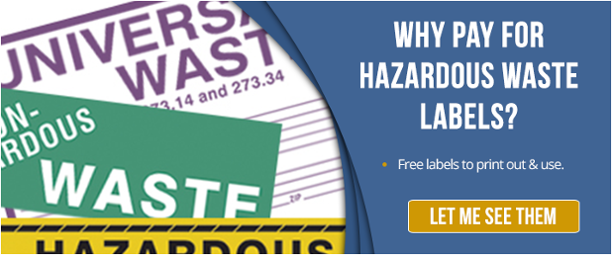As an organization that generates hazardous waste from your operations, you know how important it is to follow strict state and federal waste management guidelines.
Not doing so can result in costly fines that can set you back financially - or worse, put you out of business.
Waste management guidelines include all aspects of operations, from time and quantity limits on waste accumulation, to employee training and proper storage. They also include rules for hazardous waste labels.
To ease the regulatory burden on hazardous waste generators, one type of waste - universal waste - is permitted to include a more simplified management process. This category includes materials that are still considered hazardous, but are more commonly used.
Although regulations that oversee the management of universal waste are more simplified versus other types of hazardous waste, items that fall under this category must still include a label.
Here’s what you need to know about universal waste labels, including:
-
Acceptable waste types that fall under this category
-
Why the labels are important for your operation
-
What the labels should include to ensure your operations meet all associated regulations
Acceptable Waste Types for Universal Labels

Federal universal waste regulations state there are four types of universal waste:
-
Batteries
-
Pesticides
-
Mercury-containing equipment
-
Lamps
Batteries: Included are sealed lead acid, nickel-cadmium, lithium-ion, mercuric oxide, silver oxide and other alkaline batteries. Regulations do not include low- or non-mercury containing alkaline and carbon zinc batteries.
Pesticides: Pesticides include any substance or mixture that is intended to prevent, destroy, repel or mitigate any pest. They also include most substances that are intended to be used as a plant regulator, defoliant or desiccant. A pesticide also may be considered a universal waste if it is being recalled or is part of a managed collection program.
Mercury-containing equipment: This includes devices that contain elemental mercury, such as thermometers, thermostats, and electrical switches and relays. It’s important to confirm that the type of mercury you wish to label as universal waste fits the requirements. Some mercury-containing equipment may meet the definition as outlined above, but it isn’t considered universal waste. For example, equipment or devices that had mercury-containing components, but those pieces have been removed, do not qualify.
Lamps: Included in this category are electric lamps or light bulbs, including fluorescent, high-intensity discharge, neon, mercury vapor, high-pressure sodium and metal halide lamps. While newer light bulbs may be managed as nonhazardous solid waste, their identification must be supported with documentation.
Important note: Although the above items are listed as universal waste under federal regulations, individual states may set aside other items as well. In California, for example, in addition to the items listed above, the state also considers the following items as universal waste:
-
Electronic devices: This includes any device that is a hazardous waste (with or without a Cathode Ray Tube), including televisions, computer monitors, cell phones, VCRs and portable DVD players.
-
CRTs and CRT glass: CRTs are the glass picture tubes removed from televisions, computer monitors and other similar devices. A CRT that has been broken or processed for recycling also is included as a universal waste.
-
Non-empty aerosol cans: This include partially-full or full cans, including propane, butane and pesticides.
Read more about types of universal waste and the Federal Universal Waste Program in our article, What Is Universal Waste Disposal?
Why Universal Waste Labels Are Important
To take advantage of relaxed restrictions, universal waste generators must follow proper management guidelines. These guidelines are put into place to ensure:
-
Hazardous wastes are not released into the environment
-
That generators are prepared to handle an accidental release
-
There is a plan in place to transport the waste to a permitted facility
Universal waste labels are an important component to ensure that the above occurs. Before transport, storing and labeling the waste is critical both for identification and for record keeping.
Documenting the waste’s identity prepares others for safe handling, as well as excludes it from being subjected to the more stringent hazardous waste generation restrictions. Using labels allows generators to keep track of what’s been accumulated so that they do not violate any of the restrictions.
What Universal Waste Labels Should Include
Now that you know what types of waste can be labeled as universal, and why it’s important to follow any regulations associated with universal waste, knowing what these labels should include is critical to ensuring no violations are made.
Universal waste labels can be attached to both the item and the container. The container’s label should convey the type of universal waste that it holds, and only that particular type of waste should be added to the container.
The waste must be labeled as follows:
-
Batteries: “Universal Waste Batteries,” “Waste Batteries” or “Used Batteries”
-
Pesticides:
-
Universal Waste Canceled Pesticides: “Universal Waste - Pesticide(s)” or “Waste - Pesticides”
-
Universal Waste Recalled Pesticides: An original Federal Insecticide, Fungicide and Rodenticide Act (FIFRA) label that would be required under FIFRA if the pesticide were a product
-
Mercury-containing equipment: “Universal Waste - Mercury-Containing Equipment,” “Waste Mercury-Containing Equipment” or “Used Mercury-Containing Equipment”
-
Lamps: “Universal Waste - Lamps,” “Waste Lamps” or “Used Lamps”
Universal waste must not be stored for more than one year, so the label should demonstrate the length of time it has been accumulating. The container’s label also should include the earliest date that waste was added to it, and the item’s label should log when it became waste.
Bottom Line
Universal waste guidelines are put into place to ensure hazardous wastes are not released into the environment. Including a universal waste label with any waste that falls in this category is a critical component in ensuring your company meets all regulations.
Following these simple labeling criteria documents compliance and shows waste management responsibility.


Comment